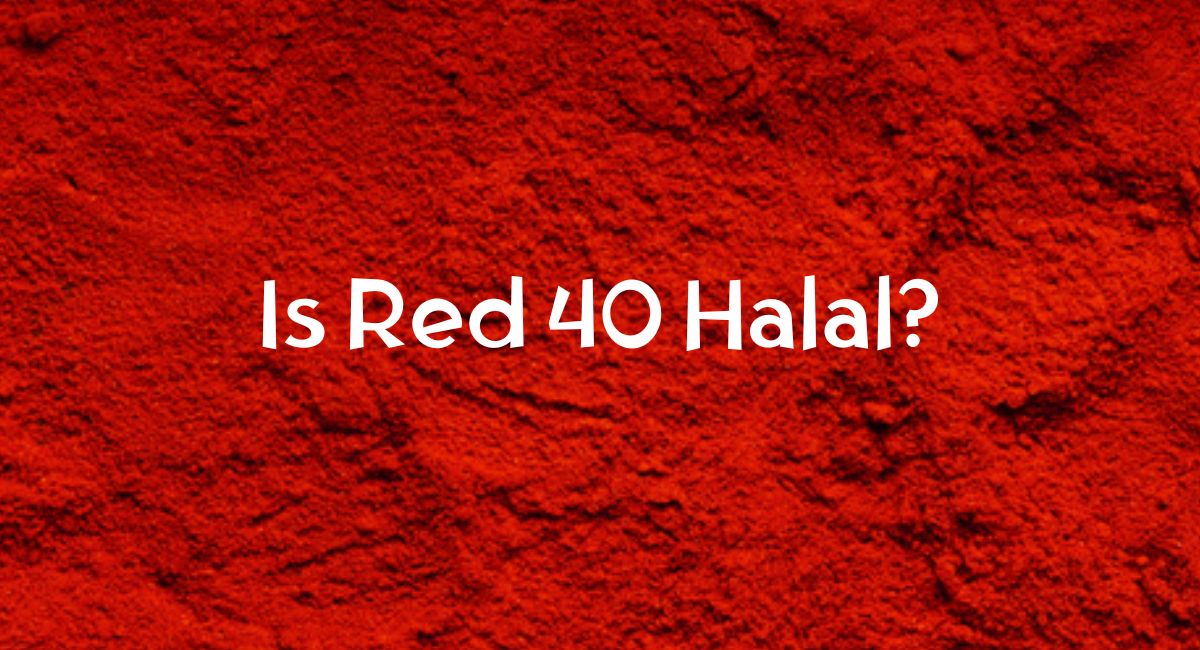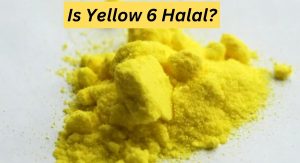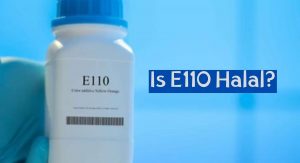In the realm of dietary considerations and religious practices, it becomes increasingly important to address the halal status of various food additives. Among these additives, Red 40, a widely used food dye, has raised questions regarding its compatibility with halal guidelines. This blog post endeavours to provide an informative and inclusive exploration of the topic, seeking to uncover the truth behind the question: Is Red 40 Halal? Let’s figure it out!
Red 40
Red 40, also known as Allura Red AC, is a synthetic red food colouring that is commonly used in the United States and other countries. It is classified as an azo dye and is widely used in various food and beverage products, including candies, desserts, carbonated drinks, and processed foods.
Red 40 is approved by the U.S. Food and Drug Administration (FDA) for use in food and beverages, and it imparts a vibrant red colour to the products. It is one of the most widely used artificial food colourings due to its stability, cost-effectiveness, and ability to produce consistent colour.
While Red 40 is considered safe for consumption by most people, it may cause allergic reactions in some individuals, especially those with a sensitivity to food dyes. Additionally, some studies have suggested a potential link between Red 40 and hyperactivity in children, although the evidence is not conclusive.
It’s important to note that the FDA regulates the use of Red 40 and sets limits on its concentration in food and beverages to ensure safety. Consumers who are concerned about food dyes or have specific dietary restrictions should carefully read product labels or consult with a healthcare professional.
How To Spot Red 40 In Food Products?
To spot Red 40 in food products, you can follow these steps:
- Read the ingredient list: Look for “Red 40” or “Allura Red AC” in the ingredient list of the food product. Ingredients are usually listed in descending order of their quantity, so Red 40 is likely to be listed early if it is a significant component.
- Look for specific names: Sometimes, food manufacturers may use alternative names for Red 40. Keep an eye out for other names such as “FD&C Red No. 40” or “E129,” as these are also used to indicate the presence of Red 40.
- Check for colour descriptions: Food products that contain Red 40 often mention it in the product description or use terms like “artificially coloured” or “contains artificial colour” on the packaging. This information can provide a clue about the presence of Red 40.
- Be cautious with bright red or pink foods: Red 40 is commonly used to give foods a vibrant red or pink colour. If a food product has a bright red or pink hue, there’s a possibility that Red 40 is used to achieve that colour.
- Use online resources: If you are uncertain about a particular food product, you can search online databases or websites that provide information about food additives. These resources can help you identify if Red 40 is commonly used in the specific product you are interested in.
Remember, it’s always a good idea to read product labels and familiarize yourself with the ingredients to make informed choices based on your dietary needs and preferences.
The Basics of Red 40

Red 40, also known as Allura Red AC, is a synthetic food dye belonging to the azo dye family. It is widely used in the food and beverage industry to enhance the appearance of various products, ranging from candies and soft drinks to baked goods and desserts. The vibrant red hue of Red 40 makes it a popular choice for manufacturers looking to create visually appealing food items.
Sources and Manufacturing Process:
Red 40 is typically derived from petroleum-based chemicals, making it a synthetic dye. The production process involves a series of chemical reactions to create the desired pigment. While the specific details of the manufacturing process may vary among manufacturers, it generally involves the diazotization of aniline, followed by coupling with a second chemical compound to form the final dye molecule.
Applications and Usage
Red 40 is used in a wide range of food and beverage products. It can be found in candies, carbonated drinks, fruit-flavoured snacks, baked goods, ice creams, gelatin desserts, and more. The versatility of Red 40 makes it a popular choice for manufacturers looking to enhance the visual appeal of their products.
Regulatory Approval and Safety
The safety of Red 40 as a food additive is regulated by various governmental authorities, such as the Food and Drug Administration (FDA) in the United States, the European Food Safety Authority (EFSA) in the European Union, and other similar agencies worldwide. These regulatory bodies conduct thorough evaluations and set limits on the acceptable daily intake of Red 40 based on extensive toxicological studies.
However, Red 40 has been associated with certain concerns and controversies. Some individuals may experience allergic reactions or intolerances to food dyes, including Red 40. These reactions can range from mild symptoms, such as hives or itching, to more severe reactions. Individuals who are known to be sensitive to food dyes should exercise caution when consuming products containing Red 40.
Moreover, there have been studies examining the potential link between Red 40 and hyperactivity in children. While some studies have suggested a possible association, the scientific evidence remains inconclusive and controversial. Further research is needed to establish a definitive connection, if any, between Red 40 and hyperactivity.
Concerns and Controversies
While Red 40 is considered halal by many certifying authorities, some individuals may have concerns regarding its potential health effects. Red 40 has been associated with allergic reactions and intolerance in certain individuals, particularly those sensitive to food dyes. Moreover, some studies have suggested a possible link between Red 40 and hyperactivity in children, although the evidence remains inconclusive and controversial.
It is essential to note that the safety of Red 40 as a food additive is regulated by governmental agencies, such as the Food and Drug Administration (FDA) in the United States and the European Food Safety Authority (EFSA) in the European Union. These regulatory bodies set acceptable daily intake limits and conduct rigorous assessments to ensure the safety of food additives, including Red 40.
What Are The Most Common Foods That Use Red 40?
Red 40, or Allura Red AC, is a widely used food colouring in various food and beverage products. Some of the most common foods that may contain Red 40 include:
- Candies: Red 40 is frequently used in the production of candies, including gummy candies, hard candies, liquorice, and jelly beans.
- Desserts and baked goods: Many desserts and baked goods, such as cakes, cookies, pastries, and frostings, may contain Red 40 to enhance their visual appeal.
- Carbonated beverages: Red 40 is commonly found in carbonated drinks like sodas, fruit-flavoured beverages, energy drinks, and some flavoured waters.
- Jams and jellies: Some brands of jams, jellies, and fruit spreads may include Red 40 for colouring purposes.
- Syrups and toppings: Certain syrups, such as strawberry syrup or flavoured dessert toppings, may use Red 40 to achieve a vibrant red colour.
- Processed snacks: Many processed snack foods, including chips, popcorn, and flavoured crackers, may contain Red 40 for colour enhancement.
- Breakfast cereals: Some breakfast cereals, particularly those with colourful shapes or artificial fruit flavours, may utilize Red 40 as a food colouring.
- Ice creams and frozen treats: Red 40 can be found in certain types of ice creams, frozen yoghurts, and popsicles to create red or pink hues.
- Sauces and dressings: Certain sauces, such as tomato-based sauces or salad dressings, may use Red 40 for colouring purposes.
It’s important to note that the use of Red 40 can vary between different brands and manufacturers. Reading product labels and ingredient lists is the best way to determine if a particular food item contains Red 40.
Is Red 40 Safe?
Red 40 (Allura Red AC) is considered safe for consumption by the regulatory authorities in the United States, including the U.S. Food and Drug Administration (FDA). Based on extensive research and scientific studies, Red 40 has been deemed safe for the general population when used within approved limits.
However, it’s important to note that some individuals may be sensitive or allergic to Red 40 or other food colourings. Allergic reactions to food colourings can manifest as symptoms like hives, itching, swelling, or respiratory issues in susceptible individuals. If you experience any adverse reactions after consuming Red 40 or any other food colouring, it is recommended to consult with a healthcare professional.
There have been concerns regarding the potential link between Red 40 and hyperactivity in children, but the scientific evidence remains inconclusive. Some studies have suggested a possible association, while others have found no significant impact on behaviour. Further research is needed to clarify this matter.
As with any food additive, the key to safe consumption is moderation and being aware of your individual sensitivities or allergies. It is advisable to read product labels and be aware of the ingredients present, including Red 40, if you have specific dietary concerns.
Regulatory authorities regularly review scientific data and conduct safety assessments to ensure the continued safety of food additives like Red 40. It is important to follow the guidelines and regulations set by these authorities and make informed choices based on your personal health considerations.
Is Red 40 Tested on Animals?
Yes, Red 40 (Allura Red AC) has undergone animal testing in the past to assess its safety for human consumption. Animal testing is a common practice in the evaluation of food additives, including food colourings, to determine potential toxicological effects and establish safe levels of consumption.
The testing typically involves administering Red 40 to animals, such as mice, rats, and rabbits, in various doses to observe any adverse effects. These studies aim to identify potential toxicity, carcinogenicity, reproductive effects, and other safety concerns. Researchers closely monitor the animals for signs of toxicity or adverse reactions to determine the dosage levels at which harmful effects occur.
The data obtained from animal testing, along with other studies, are then used by regulatory authorities, such as the U.S. Food and Drug Administration (FDA), to establish guidelines and safety standards for the use of Red 40 in food products.
It’s worth noting that there is an ongoing debate and increasing efforts to reduce and find alternatives to animal testing in the field of toxicology. In recent years, some organizations and researchers have been exploring alternative methods, such as in vitro tests and computer simulations, to reduce reliance on animal testing for safety evaluations. However, as of my knowledge cutoff in September 2021, animal testing remains a standard practice for assessing the safety of food additives, including Red 40.
Is Red 40 Halal?
Determining the halal status of Red 40 requires a comprehensive evaluation of its production methods and ingredients. As Red 40 is derived from synthetic sources, it does not fall under the category of naturally derived halal dyes. However, many halal certification agencies, such as the Islamic Food and Nutrition Council of America (IFANCA), consider Red 40 to be permissible for consumption based on scientific analysis and regulatory compliance.
These certifying authorities assess factors such as the raw materials used, potential cross-contamination during production, and adherence to relevant halal guidelines. It is important to note that halal certification can vary among different certifying bodies and regions, so it is advisable to consult the specific halal certification authority relevant to your location.
Conclusion
In conclusion, Red 40 is a synthetic food dye widely used in the food industry. While it is not naturally derived, many halal certification agencies consider Red 40 to be permissible for consumption based on scientific analysis and regulatory compliance. However, individual sensitivities and potential health concerns related to food dyes should also be taken into consideration.
As always, it is advisable to consult with religious scholars or halal certification agencies for the most up-to-date guidance on the halal status of specific food additives. By staying informed and making educated choices, we can navigate the complex landscape of food additives, including Red 40, in accordance with our dietary preferences and religious beliefs.
Frequently Asked Questions (FAQs)
Is Red 40 Vegan?
Yes, Red 40 (Allura Red AC) is generally considered vegan. Red 40 is a synthetic food colouring derived from petroleum, and it does not contain any animal-derived ingredients. It is made through chemical processes and does not involve the use of animals or animal by-products in its production. However, it’s important to note that individual brands or manufacturers may have different production processes, so it is always advisable to check the specific product’s label or contact the manufacturer to ensure their Red 40 is vegan-friendly if you have specific dietary requirements.
Is Red 40 Cruelty-Free?
Determining whether Red 40 (Allura Red AC) is cruelty-free can be a bit complex. While Red 40 itself is a synthetic food colouring and does not involve direct animal testing in its production, it’s important to note that historically, animal testing has been conducted to assess the safety of food additives, including Red 40. Therefore, it depends on the specific context in which you consider cruelty-free. If you define cruelty-free as the absence of animal testing throughout the entire supply chain, including the ingredient’s testing history, it may be challenging to categorize Red 40 as completely cruelty-free.
Does Red 40 Have Pork?
No, Red 40 (Allura Red AC) does not contain pork or any animal-derived ingredients. Red 40 is a synthetic food colouring that is chemically produced and derived from petroleum. It does not involve the use of any animal products or by-products in its manufacturing process. Red 40 is considered suitable for vegetarian and vegan diets, as it does not come from animal sources. However, it is always advisable to read product labels or contact the manufacturer directly to ensure that specific products are free from any ingredients that may be of concern.








